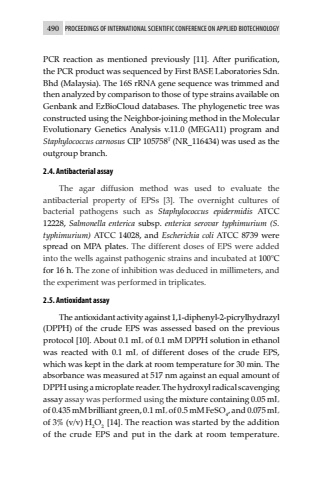Page 486 - Demo
P. 486
490 PROCEEDINGS OF INTERNATIONAL SCIENTIFIC CONFERENCE ON APPLIED BIOTECHNOLOGYPCR reaction as mentioned previously [11]. After purification, the PCR product was sequenced by First BASE Laboratories Sdn. Bhd (Malaysia). The 16S rRNA gene sequence was trimmed and then analyzed by comparison to those of type strains available on Genbank and EzBioCloud databases. The phylogenetic tree was constructed using the Neighbor-joining method in the MolecularEvolutionary Genetics Analysis v.11.0 (MEGA11) program and Staphylococcus carnosus CIP 105758T (NR_116434) was used as the outgroup branch.2.4. Antibacterial assayThe agar diffusion method was used to evaluate the antibacterial property of EPSs [3]. The overnight cultures of bacterial pathogens such as Staphylococcus epidermidis ATCC 12228, Salmonella enterica subsp. enterica serovar typhimurium (S. typhimurium) ATCC 14028, and Escherichia coli ATCC 8739 were spread on MPA plates. The different doses of EPS were added into the wells against pathogenic strains and incubated at 100%u00b0C for 16 h. The zone of inhibition was deduced in millimeters, and the experiment was performed in triplicates.2.5. Antioxidant assayThe antioxidant activity against 1,1-diphenyl-2-picrylhydrazyl (DPPH) of the crude EPS was assessed based on the previous protocol [10]. About 0.1 mL of 0.1 mM DPPH solution in ethanol was reacted with 0.1 mL of different doses of the crude EPS, which was kept in the dark at room temperature for 30 min. The absorbance was measured at 517 nm against an equal amount of DPPH using a microplate reader. The hydroxyl radical scavenging assay assay was performed using the mixture containing 0.05 mL of 0.435 mM brilliant green, 0.1 mL of 0.5 mM FeSO4, and 0.075 mL of 3% (v/v) H2O2 [14]. The reaction was started by the addition of the crude EPS and put in the dark at room temperature.


